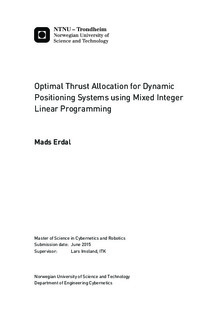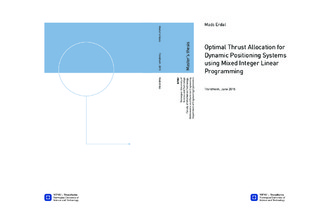| dc.description.abstract | Thrust allocation is the part in a dynamic positioning system that is responsible for giving set-points to the different actuators on a vessel in order to track a desired generalized force, which is the set of surge, sway and yaw demanded by the control system. While thrust allocation generally is solved by means of non-linear solvers, additional logical and operational constraints cannot be taken directly into account in the standard non-linear formulation. The goal of this thesis was to explore the possibilities of using Mixed Integer Linear Programming (MILP) for thrust allocation and finding a good trade off between model accuracy and problem complexity.
This thesis shows that mixed integer programming, both MILP and Mixed Integer Quadratic Programming (MIQP) are powerful tools in optimization, and by using piecewise linear approximations of non-linear functions anything can be included in the formulation. However, using piecewise linear approximations tend to greatly increase the complexity of the problem, because the approximation often must consist of many lines to be accurate enough and to counteract the effect that the solver will tend to choose solutions in the vertices of the approximation. Using logical constraints is a powerful tool for introducing forbidden sectors, and could also be used as a state variable for e.g. whether an actuator is in forward or reverse mode.
In this thesis actuators has been modelled using MILP formulations, and an LP, a QP, several MILP and a MIQP formulation of the thrust allocation problem has been presented. The thesis suggests a method to include forbidden sectors in the feasible thrust region of an azimuth thruster using big-M technique, only introducing 2 equations and 2 variables to the problem formulation. This method can also be used to model the thrust region of a propeller-rudder pair. Power minimization has been included in the MILP formulation by approximation the thrust-power relationship using a piecewise linear approximation. Asymmetry in tunnel thrusters has also been added to the problem formulation. Simulations are done in MATLAB on a model of a ship to demonstrate the differences in response between the formulations. It is suggested that if the functions in the cost function can be approximated as quadratic functions, MIQP should be used, because approximating them by use of piecewise linear approximations increases the complexity to the extent that the MIQP formulation is quicker to solve. | |

